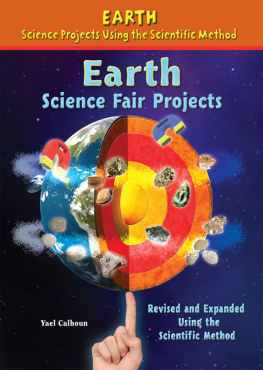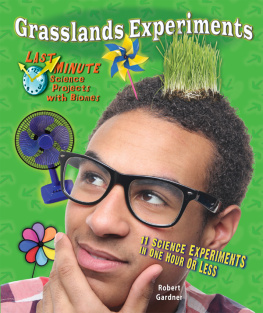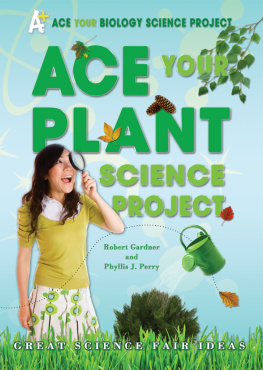Science Fair Projects Using Water, Feathers, Sunlight, Balloons, and More
Is there more air pollution inside a building or outside? Can oil be cleaned from bird feathers? How can wind be used to generate electricity? Using easy-to-find materials and the scientific method, you can learn the answers to these questions and more. If you are interested in competing in science fairs, the book contains lots of great suggestions and ideas for further experiments about environmental science.
ABOUT THE AUTHOR
Thomas R. Rybolt and Robert C. Mebane have each taught chemistry at the University of Tennessee at Chattanooga for more than twenty-five years. Dr. Rybolt and Dr. Mebane have co-authored fifteen children's science books, including the popular Adventures with Atoms and Molecules series, which has been introducing young people to the joys of science since 1986.
Acknowledgments: We thank Jacqui Casey for her help in testing some experiments and Karen Rybolt for her help in developing Experiment 4.1 (Oil Spills).
Carolina Biological Supply Company
2700 York Road
Burlington, NC 27215-3398
(800) 334-5551
http://www.carolina.com
Connecticut Valley Biological Supply Company
82 Valley Road
P.O. Box 326
Southampton, MA 01073
(800) 628-7748
http://www.ctvalleybio.com
Delta Education
80 Northwest Boulevard
P.O. Box 3000
Nashua, NH 03061-3000
(800) 258-1302
http://www.delta-education.com
Edmund Scientifics
60 Pearce Avenue
Tonawanda, NY 14150-6711
(800) 728-6999
http://scientificsonline.com
Educational Innovations, Inc.
362 Main Avenue
Norwalk, CT 06851
(888) 912-7474
http://www.teachersource.com
Fisher Science Education
4500 Turnberry Drive
Hanover Park, IL 60133
(800) 955-1177
http://www.fishersci.com
Frey Scientific
80 Northwest Boulevard
Nashua, NH 03063
(800) 225-3739
http://www.freyscientific.com/
NASCO-Fort Atkinson
901 Janesville Avenue
P.O. Box 901
Fort Atkinson, WI 53538-0901
(800) 558-9595
http://eNasco.com
NASCO-Modesto
4825 Stoddard Road
P.O. Box 3837
Modesto, CA 95352-3837
(800) 558-9595
http://www.eNasco.com
Sargent-Welch
P.O. Box 4130
Buffalo, NY 14217
(800) 727-4368
http://www.sargentwelch.com
Science Kit & Boreal Laboratories
777 East Park Drive
P.O. Box 5003
Tonawanda, NY 14151-5003
(800) 828-7777
http://sciencekit.com
Wards Natural Science
P.O. Box 92912
Rochester, NY 14692-9012
(800) 962-2660
http://www.wardsci.com

Image Credit: Shutterstock
The earths atmosphere is made up of several layers, beginning at sea level with the troposphere.
We live at the bottom of a sea of air called the atmosphere. Unlike the ocean, this sea is not made of water and salts. Earths atmosphere is made up of a mixture of gases. Dry air is about 78 percent nitrogen (N2), 21 percent oxygen (O2), 1 percent argon (Ar), and trace amounts of carbon dioxide (CO2) and other gases. Humid or wet air may contain up to 4 percent water (H2O). The atmosphere also contains many small particles of dust.
Through the process of photosynthesis, plants use carbon dioxide from the atmosphere and water from the ground to produce oxygen gas. Green plants use photosynthesis to produce molecules that they use for growth and energy. Animals, including humans, use oxygen and release carbon dioxide. Oxygen and carbon dioxide gases in the atmosphere link plants and animals together in an amazing balance of nature.
Like a blanket, water in the atmosphere helps trap heat energy around the earth and keeps the planet from getting too cold. Carbon dioxide also helps trap heat energy. However, the amount of carbon dioxide and some other greenhouse gases has been increasing. The increase in carbon dioxide comes from the burning of fossil fuels such as coal, oil, gasoline, and natural gas. When these fuels are burned, carbon dioxide is released into the air.
Scientists think the continuing increase in carbon dioxide could cause the average temperature around the earth to increase by 2 to 6F (1 to 3.5C) over the next 50 to 100 years. These changes could cause sea levels to rise, seasonal flooding and droughts to increase, faster extinction of species, spread of tropical diseases, more violent storms, and possible decreases in food production. On the other hand, when solar photovoltaic cells or wind turbines are used for generating electrical energy, carbon dioxide gas is not produced. Relying more on solar and wind energy and less on fossil fuels could reduce the harmful effects of global warming.
The atmosphere is made of several layers. Temperature differences help define these layers (see ). The troposphere extends from sea level up to about 16 km (10 mi) and contains most of the atmospheres air, water vapor, and dust. This lower level is where the earths weather occurs. The stratosphere extends from 16 km to 50 km (10 mi to 31 mi) above the surface. The stratosphere has much thinner air, because the molecules are farther apart. Within the stratosphere is a layer with a high concentration of ozone. This ozone blocks a great deal of the ultraviolet light from reaching the earth. This light would be harmful to plants and animals. Above the stratosphere is the mesosphere, which extends up to 80 km (50 mi). Above the mesosphere is the thermosphere, which gradually becomes the same as outer space. The lower part of the thermosphere helps block harmful solar and cosmic radiation from reaching the earth.

: The four layers of the atmosphere have different temperature trends.

Image Credit: Shutterstock
Surface water collects in ponds, lakes, and streams, flowing to join larger rivers leading to the sea.
The cells of all living things contain water, and water is essential to keep them living. The human body is about 65 percent water. Humans around the world have a daily need for fresh, clean drinking water.
Although 70 percent of the earths surface is covered with water, most of this water is salt water. Imagine all the water on the earth being represented by just one hundred bottles. Of all these bottles, 97 are filled with salt water that humans cannot drink. Two of the bottles are filled with frozen water, representing the freshwater that is trapped in polar ice, glaciers, and snow. Only one single bottle out of all one hundred is drinkable freshwater.
More than half of all freshwater is trapped underground. Freshwater that is trapped underground, above layers of clay or rock, is called groundwater. Groundwater is often found not as free water, but as water filling the pores of rocks and geologic materials. Groundwater is the source of almost half of the freshwater used in the United States. These underground sources of water are called aquifers. Rainwater (and other precipitation) goes down through surface soil and sand to refill these aquifers. The remaining water in all the rivers, lakes, streams, and marshes makes up less than one percent of the earths total freshwater supply.
Pollution anywhere on the ground tends to enter water because water moves over the surface of the earth and carries pollution with it. Excess fertilizer, pesticides, herbicides, waste chemicals from industrial processes, and even medicines that our bodies do not completely use (such as antibiotics) can eventually reach and pollute water supplies. In many areas around the world, untreated sewage gets into lakes and rivers and contaminates the drinking water. When sewage is treated prior to being released into the environment, and when industries operate with minimum waste, our water sources are cleaner.
















